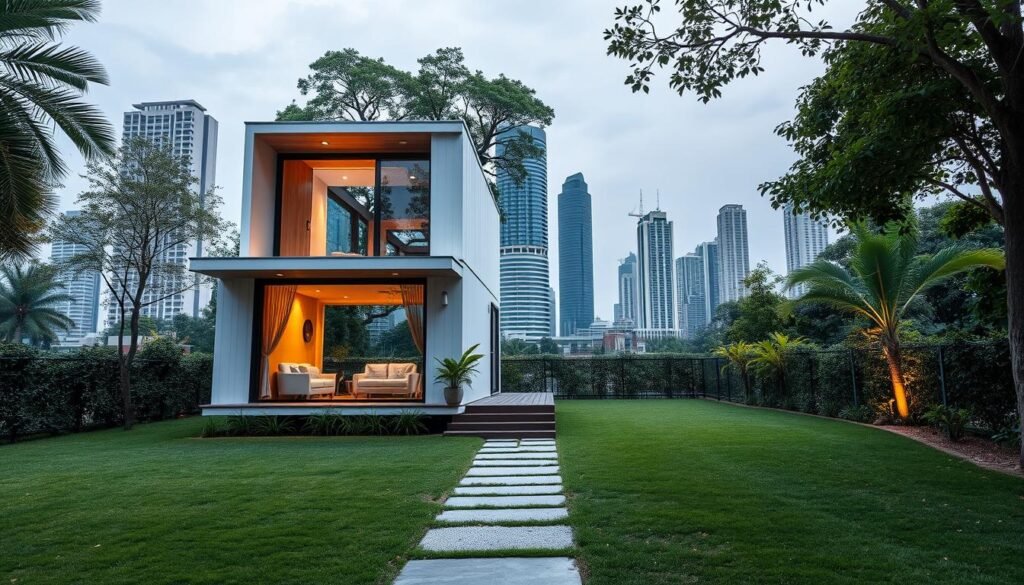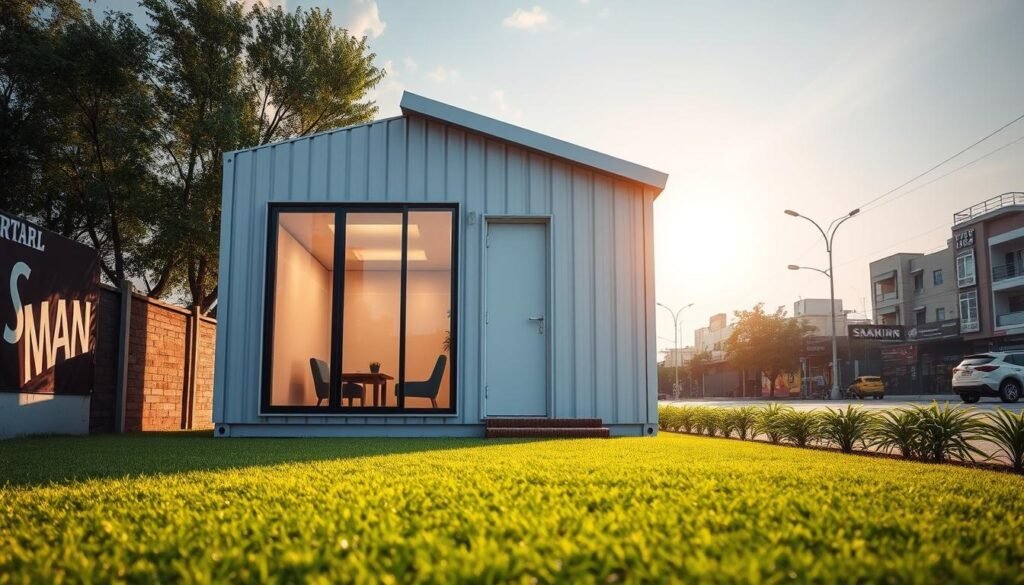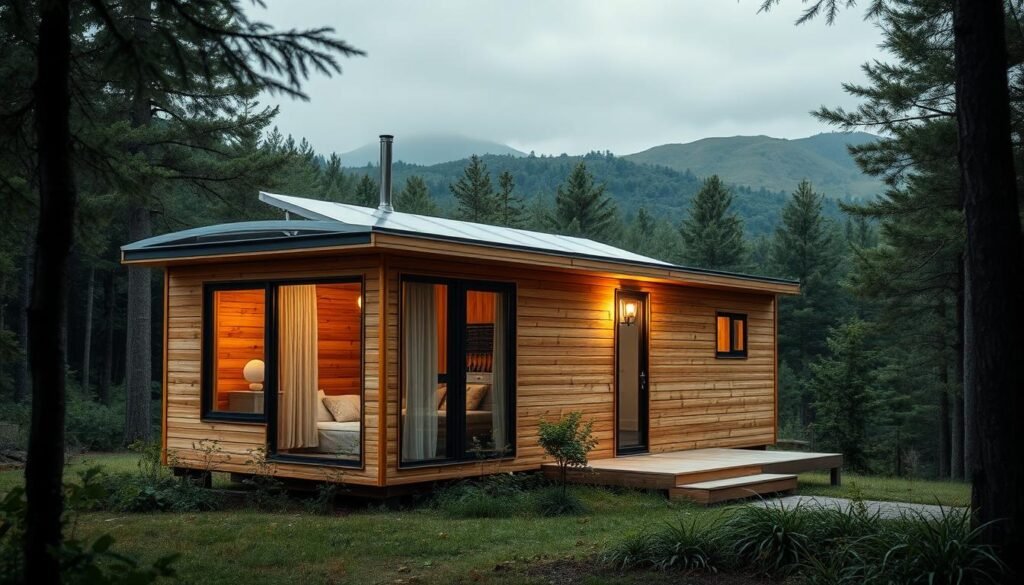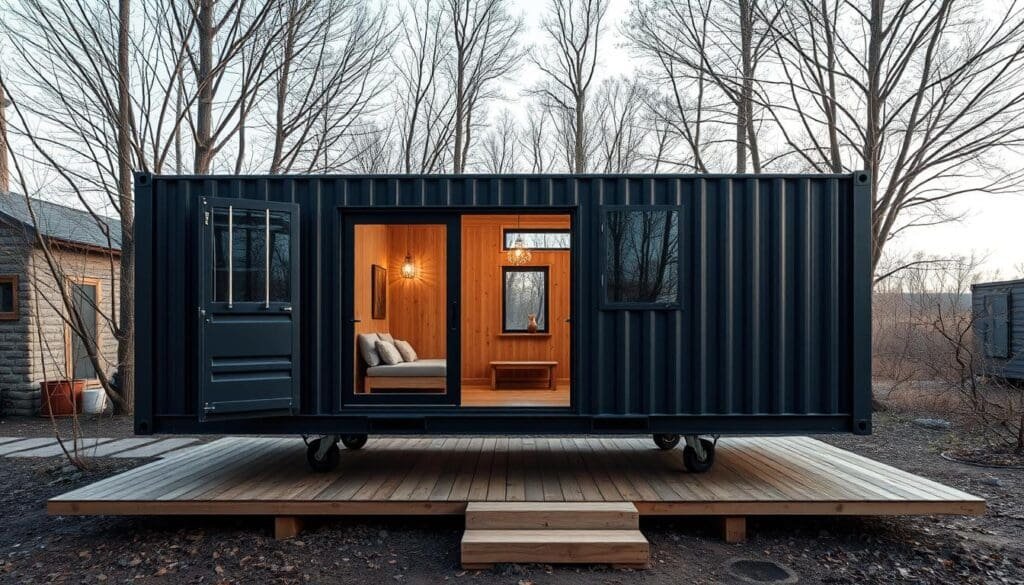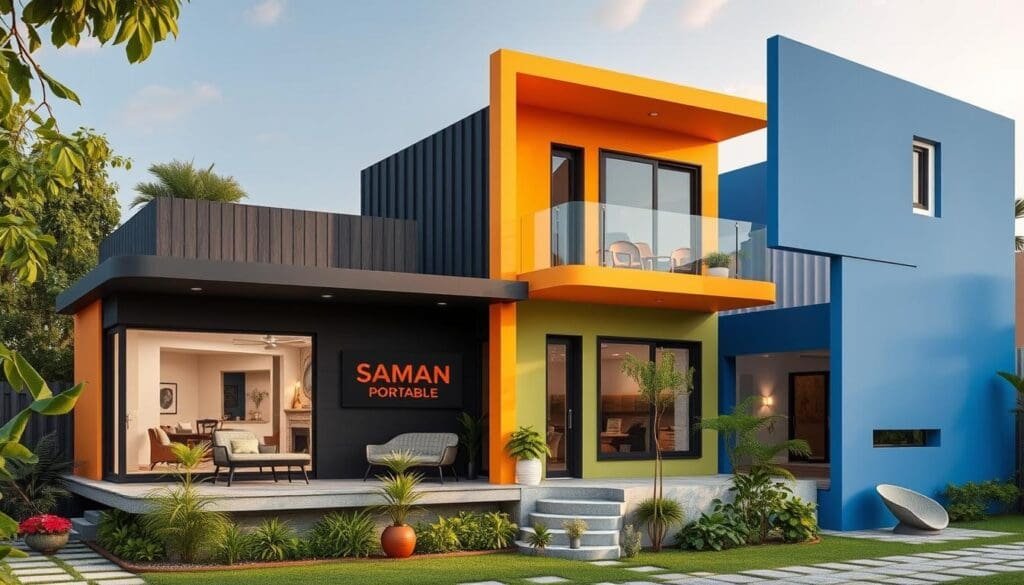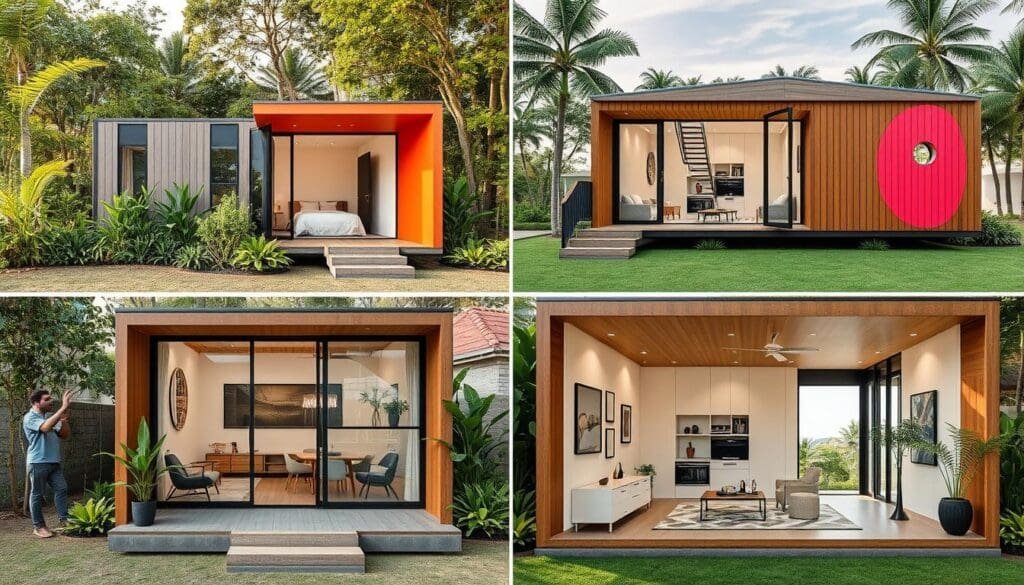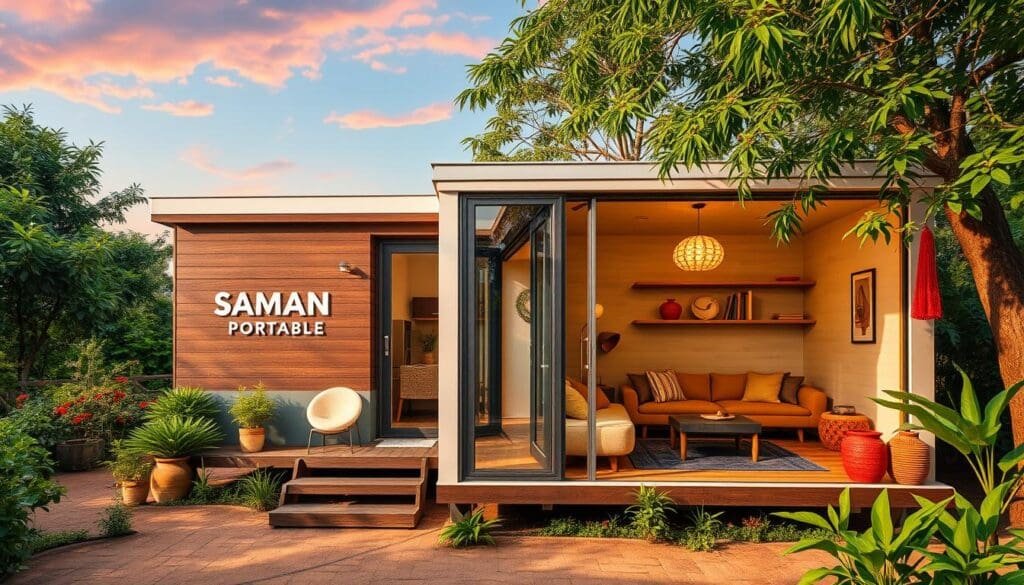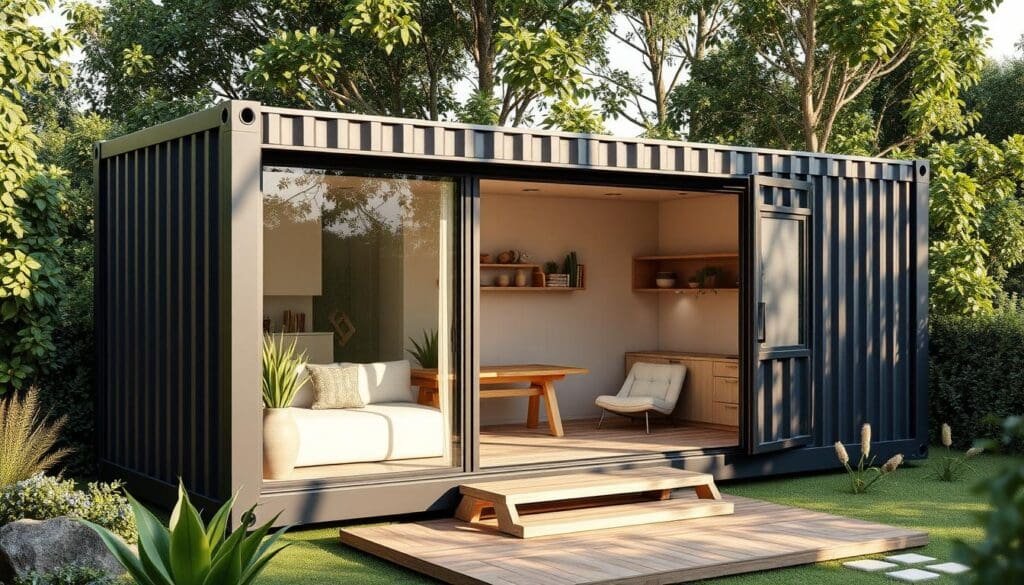Container Home Architect: Redefining Modern Sustainable Living with Unique Designs
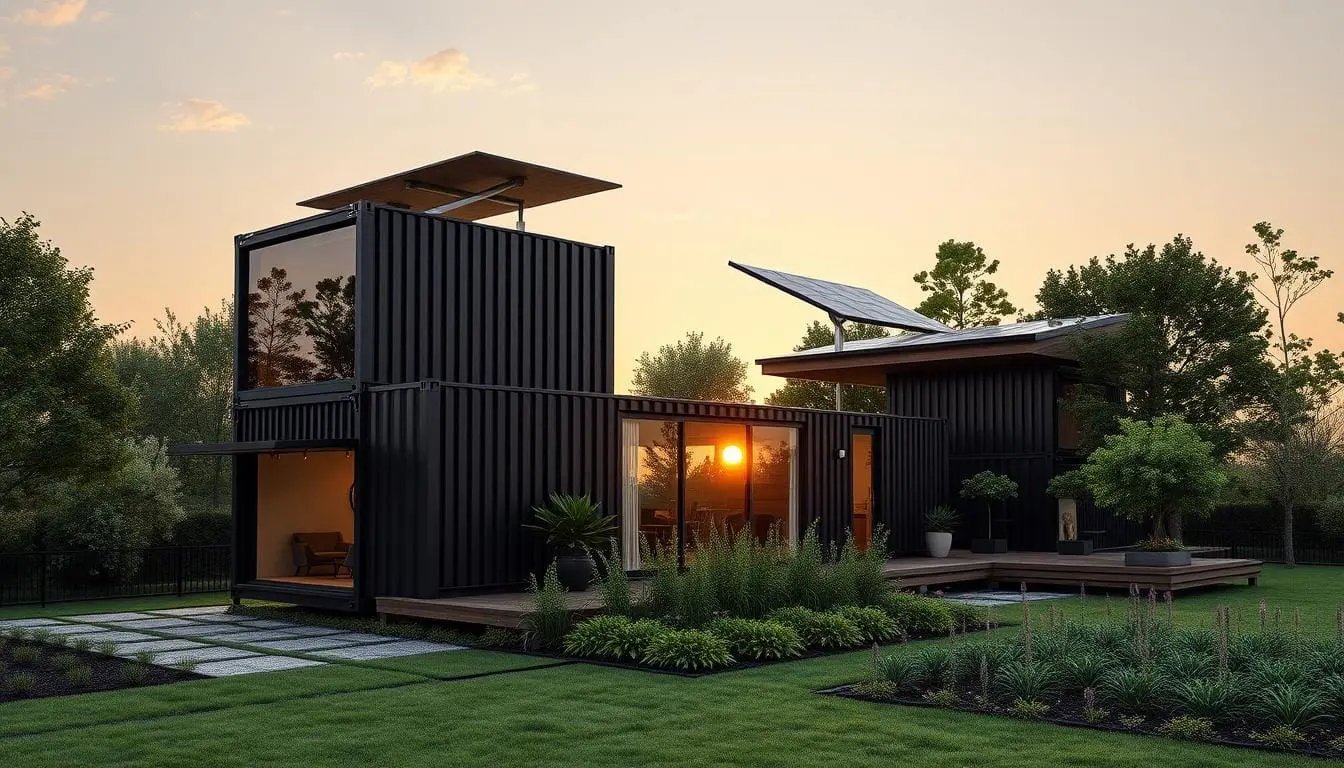
In India’s busy cities, a big change is happening. Container homes, made from old shipping containers, are becoming popular. They mix industrial style with green design.
But what makes these homes special? And how are architects changing the way we live in them?
Key Takeaways
- Container homes offer a sustainable and cost-effective solution to housing challenges in India’s growing urban centers.
- Architects are designing unique and customizable container homes that challenge traditional notions of residential architecture.
- These dwellings blend industrial aesthetics with eco-friendly features, addressing concerns about population growth, high property costs, and environmental impact.
- Innovative container home designs are revolutionizing the way we think about urban living and redefining the future of sustainable housing.
- Container home architect is at the forefront of this transformation, showcasing the endless possibilities of repurposed shipping containers as modern living spaces.
Ever thought about how container homes are changing sustainable living in India? Learn about the creative designs and forward-thinking architects leading this urban housing revolution.
The Evolution of Container Architecture in Modern Housing
The humble shipping container has changed a lot. It went from being just a way to transport goods to a key part of modern homes. In 1956, Malcolm McLean made the first standard shipping container. This was a big step for modern housing.
From Shipping Vessels to Revolutionary Homes
Shipping containers are now used for custom container homes and prefab container homes. Architects like Nicholas Lacey in 1987 and LOT-EK in 2002 have made them more than just boxes. They added cool features and made them expandable.
Impact on Urban Development
Container homes have changed cities for the better. They offer affordable, green housing in crowded areas. These homes use space well, making them perfect for city living.
Sustainable Architecture Movement
The green building movement loves custom container homes and prefab container homes. They use green tech and recycled materials. These homes lead the way to a greener future.
| Key Milestones in Container Architecture | Year |
|---|---|
| Standardized shipping container introduced by Malcolm McLean | 1956 |
| First documented use of a shipping container as a living space by British architect Nicholas Lacey | 1987 |
| LOT-EK introduces the Mobile Dwelling Unit (MDU), incorporating expandable elements in a container structure | 2002 |
| Adam Kalkin debuts the Illy Push Button House at the Venice Biennale, featuring a shipping container that unfolds into a fully furnished apartment | 2006 |
| Aalto University students develop the Liina Transitional Shelter, showcasing expandable container homes for disaster relief | 2010 |
| Australian design G-pod Dwell gains international attention for its innovative push-button system that doubles living space | 2015 |

Understanding the Fundamentals of Container Home Design
Container home design is changing how we see homes. It uses old shipping containers to make homes that are strong, cheap, and good for the planet.
At the core of container home design is the shipping container. Architects and modular housing experts turn these into cozy homes. They make the most of the space, even in small containers.
Designing a container house plans means thinking about insulation, air flow, and changes to the structure. This way, designers make homes that are not just useful but also nice to live in.
Key Considerations in Container Home Design
- Space Optimization: Designers use the container’s size to create smart floor plans. This makes the space both cozy and efficient.
- Insulation and Ventilation: Good insulation and air flow keep the home comfortable. They also help save energy and protect from bad weather.
- Structural Modifications: Adding supports and foundations makes the home strong and safe. This is key for its long life.
- Interior Finishes: Choosing top-notch finishes makes the home look great. It shows off the owner’s style and makes the space welcoming.
Knowing these design basics helps container house plans and modular housing experts build homes that are both modern and practical. They mix style with function in a way that’s both new and useful.

Container Home Architects: Leading the Sustainable Housing Revolution
Container home architects are at the forefront of sustainable living, exploring options like sustainable porta cabins. They turn shipping containers into homes that are both beautiful and functional. These experts have the skills to make industrial containers into cozy, modern living spaces.
Professional Expertise and Specialization
These architects are experts in making homes from shipping containers. They focus on using materials that are good for the planet. They also know how to make the most of the space in these containers.
Design Philosophy and Approach
Container home architects aim for simplicity and function. They blend industrial looks with modern comforts. They find creative ways to use every inch of space in these containers.
Innovation in Spatial Planning
These architects are great at making the most of shipping containers. They plan out the space carefully. This includes smart storage and the right placement of windows.
| Eco-friendly Home Architect Specialties | Innovative Home Design Features |
|---|---|
|
|

Container home architects are key to the sustainable housing movement. They turn industrial materials into homes that are good for the planet. Their skills and creativity are changing how we live sustainably.
Structural Considerations and Engineering Challenges
Designing prefab container homes and custom container homes comes with unique challenges. Architects face the task of turning shipping containers into sustainable homes. This requires creative solutions and specialized knowledge.
One big issue is making the container strong enough, especially when stacking them. Shipping containers are built to handle weight, but removing sides can make the floor and roof unstable. Experts help by adding reinforcements and using special welding.
Insulation is also key in container home design. Architects use materials like spray foam to keep the container stable and control temperature. They plan carefully to ensure the home meets building codes and stays strong.
Engineers must also think about the foundation and how much weight the container can hold. They follow international standards like ISO 1496. This work leads to safe, durable, and cozy homes that break new ground in building.

Architects and engineers are changing the game in affordable, sustainable housing. They use shipping containers in new ways, making modern living more accessible. Their skills and creativity are shaping the future of homes.
Innovative Design Solutions for Container Homes
Using old shipping containers for homes started in the early 2000s. These homes are cheap, quick to build, and good for the planet. They work well in cities and far-off places too.
Space Optimization Techniques
Architects make the most of space in container homes. They use furniture that does more than one thing and smart storage. This makes the small space feel bigger.
Multi-Container Configurations
Putting several containers together makes bigger homes. For example, a house in New Zealand was made from five containers. It’s 1700 Sq.Ft. and fits the climate well.
A house in the Andes was built with 12 containers. It gets lots of sunlight and air.
Integration with Natural Surroundings
Designing homes that fit with nature is key. Architects use big windows, green roofs, and outdoor areas. This makes the home feel part of the environment.
A big house in the UK shows how light and shadow can add character. The Grillagh Water House in Northern Ireland has a special metal façade.

The Container Cabin is a cozy retreat. It has a unique shape inside and out. The Joshua Tree Residence has a cool design that lets you see the views.
The Ty Kelly Residence in Montana is small but special. It’s made from old materials, including two containers.
The Beach Box in Amagansett is a luxury home. It’s 2000 Sq.Ft. and has lots of nice features. Container homes are getting more popular because they’re good for the planet and affordable.
Sustainability Features and Eco-Friendly Materials
Container homes are great for the planet because they use old materials and smart design. Eco-friendly home architects lead this effort. They add things like solar power, special insulation, and natural air flow. This makes homes that are good for the earth and cut down on carbon emissions.
One big plus of container homes is using clean energy like solar panels and wind turbines. These help us not use as much power from the grid. This makes living in these homes better for the planet and more independent.
Stuff like spray foam insulation keeps the home warm or cool without using a lot of energy. This means you don’t need to use as much power to heat or cool your home. It makes the home more energy smart.
- Container homes often use materials like old wood and paints that don’t harm the air.
- They have special air systems that help move air around. This means you don’t need to use as much air conditioning.
- Using old shipping containers as the base of the home is good for the environment. It cuts down on waste and saves resources.
| Sustainability Feature | Benefit |
|---|---|
| Renewable Energy Sources | Less need for regular power, lower carbon footprint |
| Advanced Insulation Techniques | Keeps the temperature right, uses less energy |
| Natural Ventilation Systems | Uses less air conditioning, better air flow |
| Sustainable Materials | Less waste, better for the environment |
The green features and materials in container homes show the dedication of eco-friendly home architects. They aim to make homes that are kind to the earth. This helps people live in a way that’s better for our planet.

Cost Analysis and Economic Benefits
Custom container homes and prefab homes offer big economic wins. They are made from recycled materials and built in modules. This makes them cheaper upfront than traditional houses.
Initial Investment vs. Long-term Savings
The first cost of a container home might seem high. But, the savings over time are huge. They are very energy-efficient, which means lower bills. Plus, steel containers need less upkeep, saving money in the long run.
Construction Timeline Advantages
Container homes are built fast. Their modules can be put together quickly on-site. This saves on labor costs and lets people move in sooner. It’s a big win for both homeowners and builders.
Maintenance Considerations
Container homes save money in the long run, but they need some care. Keeping rust away and insulating well is key. With the right upkeep, they offer a smart, green living choice.
The global market for container homes was worth USD 61.83 billion in 2023. It’s expected to hit USD 108.70 billion by 2032, growing 6.7% annually. As people look for affordable, eco-friendly homes, container homes are becoming more popular.
Interior Design Strategies for Container Living
The trend of container house plans is growing. Interior designers are finding new ways to make these small spaces cozy and useful. They focus on using space well and creating a beautiful look, making container homes a new way to live sustainably.
Light colors are key in making these homes feel bigger. Using multi-functional furniture and smart storage helps keep things tidy. Open floor plans also help, making the space feel bigger by connecting different areas smoothly.
Big windows and glass doors let in lots of natural light. This makes the home feel airy and connected to nature. Designers stick to simple, clean lines and pick decor carefully to keep the space feeling open and uncluttered.

Experts in innovative home design can create detailed plans to use every inch wisely. This ensures a home that is both beautiful and practical in these unique container house plans.
| Design Element | Impact on Container Home Living |
|---|---|
| Light Colors | Enhances the perception of space and openness |
| Multi-Functional Furniture | Optimizes limited space and maximizes functionality |
| Open Floor Plans | Creates a seamless flow and sense of spaciousness |
| Large Windows and Glass Doors | Brings in natural light and connects the interior with the outdoors |
| Minimalist Design | Avoids clutter and maintains a clean, uncluttered aesthetic |
Climate Adaptation and Environmental Controls
Eco-friendly home architects and sustainable living fans know climate adaptation is key in container home design. They use innovative insulation, ventilation, and temperature control to keep homes comfy and energy-efficient.
Insulation Solutions
Good insulation keeps container homes cozy. Spray foam and rigid foam boards are top picks for their thermal power. Architects also choose eco-friendly options like recycled denim to cut down on carbon.
Ventilation Systems
Good air flow is vital for indoor air quality in container homes. Architects create custom systems with natural and mechanical ventilation. This mix ensures fresh air and climate control.
Temperature Management
Passive solar design and smart window placement help manage temperatures. In hot areas, reflective paints and green roofs lower heat. Insulation and thermal mass keep homes cool, saving energy.
By focusing on climate adaptation and green controls, eco-friendly architects are changing how we live in container homes.

Legal Requirements and Building Codes
As container home architects and modular housing experts explore sustainable living, they must understand legal rules and building codes. These rules can change a lot depending on where you are. Some places have special rules just for container homes.
In the United States, most cities have rules about where you can build. Houston, Texas, is an exception. These rules help decide what you can build and how close it can be to others. The US uses the International Residential Code and International Building Code for building rules. These codes get updated often to keep up with new standards.
To build a shipping container home, you need the right permits. These show you followed the building codes and rules. Each state might have its own rules, like the Massachusetts State Building Code. Knowing these rules well is key to avoid problems with your project.
| State | Key Building Regulations for Container Homes |
|---|---|
| California | Container homes must follow the California Building Standards Code (Title 24). Some areas have extra rules. Los Angeles has special rules for earthquake safety. |
| Texas | Texas is more flexible, often using the International Residential Code (IRC). But, local areas might have their own rules. Houston’s rules are based on local building codes and zoning laws. |
| Florida | Florida focuses on wind safety because of hurricanes. The Florida Building Code sets standards for wind resistance. Miami-Dade County has extra rules for hurricane safety. |
Following these rules is important for safety and legality. Working with skilled container home architects and modular housing experts can make things easier. They help with the rules, make the process smoother, and might even save you money and time.

Case Studies: Successful Container Home Projects
Container homes are changing the game worldwide. They show how versatile and effective portable container cabins can be in modern architecture. These projects prove that custom container homes can work in cities, countryside, or mixed areas.
Urban Applications
In cities, container homes are making a big impact. The Joshua Tree Residence in California uses a starburst pattern with shipping containers. Meanwhile, the Nomad Living Guesthouse in Portugal offers luxury in three containers. These examples show that even in tight spaces, creative homes are possible.
Rural Developments
In the countryside, container homes blend well with nature. The Mill Junction Student Housing in South Africa uses containers and grain silos for affordable housing. The HO4+ model by SAMAN Portable Office Solutions in North America shows how to create big, stylish homes from containers.
Mixed-Use Designs
Container homes are also great for mixed-use projects. A project in Bangalore, India, shows a 900 square foot home made from four containers. It cost 10 lakh Indian Rupees. These designs can mix homes with offices or small businesses.
These examples inspire us to think differently about living spaces. Container homes are affordable and versatile. They could change how we build homes and cities in the future.
| Project Name | Location | Description | Cost |
|---|---|---|---|
| The Joshua Tree Residence | California, USA | Unique starburst pattern using multiple shipping containers | N/A |
| Nomad Living Guesthouse | Portugal | Luxury living experiences within three repurposed shipping containers | N/A |
| Mill Junction Student Housing | South Africa | Combination of shipping containers and grain silos for affordable student housing | N/A |
| HO4+ model by Honomobo | North America | Spacious and stylish living environment created using four shipping containers | N/A |
| Container Home in Bangalore | Bangalore, India | 900 square feet container home built using four shipping containers sourced from Chennai | 10 lakh Indian Rupees |
Future Trends in Container Home Architecture
The future of container homes looks bright, with a focus on being green and using new tech. Architects are working on adding smart home features to save energy. They’re also making homes that use solar panels and wind turbines.
New insulation materials like spray foam and aerogel will make homes more energy-efficient. This means homes will be cozy and good for the planet. People want homes that don’t rely on the grid, with systems for saving water and growing food indoors.
Cities are turning to container homes to solve housing problems. They’re a big part of urban planning now. Designers are trying out new ways to use multiple containers, making homes that are truly unique.
FAQ
What are the unique features and benefits of container homes?
Container homes are made from old shipping containers. They offer a green and creative way to solve housing needs. These homes are strong, affordable, and good for the planet.
How do container home architects approach the design process?
Architects of container homes know how to turn shipping containers into homes. They mix design skills with caring for the environment. Their designs are simple, useful, and green, making the most of the space in containers.
What are the key structural and engineering considerations in building container homes?
Building container homes is a special challenge. It involves making the container strong, keeping it warm or cool, and adding windows and doors. Architects and engineers make sure these homes are safe, sturdy, and cozy, following local building rules.
How do container home designers maximize space and functionality?
Designers use smart ideas to make the most of space in container homes. They use furniture that does more than one thing, clever storage, and open layouts. They also connect homes to nature with big windows, green roofs, and outdoor areas.
What sustainability features are incorporated into container home design?
Container homes are green because they use old materials and eco-friendly designs. They have solar power, good insulation, natural air flow, and green finishes. These features help reduce harm to the environment and save energy.
What are the economic benefits of choosing a container home?
Container homes are cheaper to start and build than regular houses. They save money over time because they use less energy and need less upkeep. But, the cost can change based on how complex the design is, where it’s located, and how customized it is.
How do container home architects address legal requirements and building codes?
Architects of container homes must follow local laws and building codes, which can differ a lot. They work with local officials to meet zoning rules, building strength, fire safety, and energy use standards. They often meet the same standards as regular houses.
What are the emerging trends in container home architecture?
The future of container homes looks greener and more tech-savvy. There will be more smart home tech, eco-friendly materials, and complex designs. Off-grid homes with solar power and water saving systems are also becoming popular, along with homes with vertical gardens and urban farms.
 Container Cafe
Container Cafe
















































































